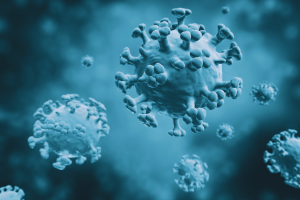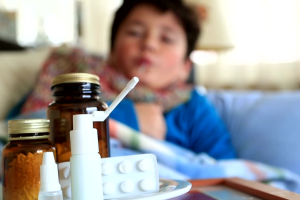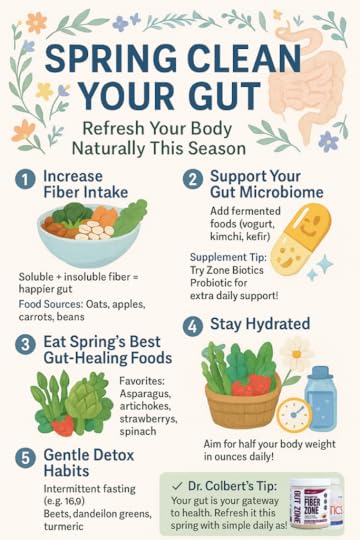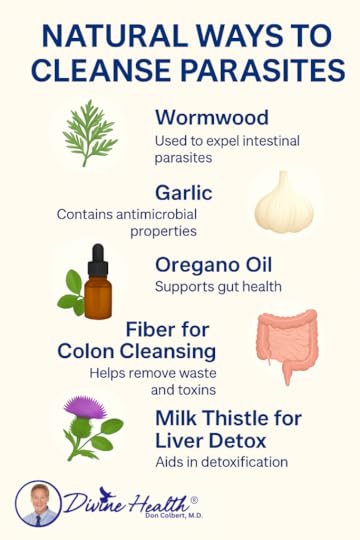Don Colbert's Blog, page 6
April 28, 2025
Spring Clean Your Gut: 5 Ways to Reset Your Digestive Health Naturally
Spring is a season of renewal, not just for our homes and schedules but also for our bodies. As nature comes alive with new growth, it’s the perfect time to refresh your gut health, too. A well-functioning digestive system is crucial for nutrient absorption, immune support, energy levels, and even mood regulation. In fact, emerging research underscores the profound connection between gut health and overall well-being. Let’s dive into five natural ways to “spring clean” your gut and set the foundation for vibrant health.
1. Increase Your Fiber IntakeFiber acts as nature’s broom for the digestive tract, helping to remove waste, feed beneficial gut bacteria, and regulate bowel movements. Studies have shown that a high-fiber diet is associated with greater microbial diversity, which supports immunity and reduces inflammation (Makki et al., 2018, Cell Host & Microbe).
There are two main types of fiber:
Soluble fiber dissolves in water and forms a gel-like material. It’s found in foods like oats, apples, carrots, and beans.Insoluble fiber promotes movement through your digestive system and is found in whole grains, nuts, and vegetables like cauliflower and green beans.If your busy lifestyle makes it challenging to get enough fiber daily, Dr. Don Colbert developed Fiber Zone as a convenient, high-quality source of both soluble and insoluble fibers. It can be an excellent complement to a fiber-rich diet, ensuring your gut stays on track.
2. Support Your Gut Microbiome with ProbioticsThe trillions of bacteria in your gut, collectively known as the microbiome, play a pivotal role in digestion, immunity, and even mental health. A 2020 review in Frontiers in Immunology highlights how probiotics can help rebalance gut flora, especially after periods of stress, illness, or poor diet.
Incorporate fermented foods like:
Yogurt with live culturesKefirSauerkrautKimchiMisoFor those who want extra support, Zone Biotics Probiotic offers a highly concentrated, physician-formulated blend of beneficial bacteria designed to optimize your gut health, particularly when dietary sources are limited.
3. Embrace Seasonal, Gut-Healing FoodsSpring brings an abundance of fresh fruits and vegetables rich in prebiotic fibers, polyphenols, and antioxidants that nourish good gut bacteria. Some top spring picks include:
Asparagus (high in prebiotics)Artichokes (rich in inulin, a prebiotic fiber)Strawberries and blueberries (loaded with polyphenols)Leafy greens like spinach and arugula (support digestive enzymes)Prebiotic foods feed the beneficial bacteria already living in your gut, helping them thrive and crowd out harmful pathogens.
4. Hydrate WellWater is essential for maintaining the mucosal lining of the intestines and supporting the movement of waste through the digestive tract. Dehydration can contribute to constipation and a sluggish digestive system.
Aim for:
At least half your body weight in ounces of water dailyInfusing water with lemon, cucumber, or mint for added nutrients and flavorProper hydration works synergistically with fiber intake, maximizing its benefits.
5. Practice Gentle Detox HabitsSpring is often associated with detoxification, but harsh cleanses and extreme fasts can do more harm than good. Instead, adopt gentle, sustainable habits that naturally support your body’s detoxification pathways, including the gut:
Intermittent fasting (e.g., 16/8 method) to give your gut a breakDry brushing to stimulate lymphatic flowIncorporating liver-supportive foods like beets, dandelion greens, and turmericPairing these practices with targeted supplements, like Fiber Zone for digestive support and Zone Biotics Probiotic for gut flora balance, can enhance your springtime gut reset naturally and safely.
Final Thoughts
As Dr. Colbert often reminds us, “Your gut is your gateway to health.” Spring offers a beautiful opportunity to refresh, reset, and renew your digestive system with natural, sustainable habits. By increasing fiber, nurturing your microbiome, choosing seasonal produce, staying hydrated, and embracing gentle detox strategies, you can support vibrant gut health all year long.
If you’re looking for convenient ways to enhance your gut reset journey, consider adding trusted, physician-developed options like Fiber Zone and Zone Biotics Probiotic to your daily routine. Here’s to a season of renewal—inside and out!
References:
Makki, K., Deehan, E. C., Walter, J., & Bäckhed, F. (2018). The Impact of Dietary Fiber on Gut Microbiota in Host Health and Disease. Cell Host & Microbe, 23(6), 705–715.Plaza-Diaz, J., Ruiz-Ojeda, F. J., Gil-Campos, M., & Gil, A. (2020). Mechanisms of Action of Probiotics. Frontiers in Immunology, 11, 624.
The post Spring Clean Your Gut: 5 Ways to Reset Your Digestive Health Naturally appeared first on .
April 17, 2025
🧬 Could a Hidden Gene Be Causing Your Fatigue, Brain Fog, or Depression?
If you’re struggling with chronic fatigue, low mood, anxiety, or brain fog, the real culprit may be genetic — and surprisingly common. In this eye-opening episode, Dr. Don Colbert, MD is joined by his son Kyle, wife Mary, and daughter-in-law Meredith to explore a powerful but often overlooked factor in your health: the MTHFR gene mutation.
This mutation affects nearly 50% of Americans and plays a critical role in how your body creates energy, supports brain function, regulates mood, and detoxifies. Yet most people have never been tested for it — and continue to suffer silently from symptoms that could be addressed naturally.
🔍 What You’ll Learn in This Episode:✔️ What the MTHFR gene does and why it’s essential for mental clarity, mood, cardiovascular health, and hormone balance
✔️ How homocysteine, a toxic amino acid, builds up in the body due to MTHFR dysfunction — and how it’s linked to heart disease, Alzheimer’s, osteoporosis, and even cancer
✔️ The difference between minor (heterozygous) and major (homozygous) mutations — and what each means for your health
✔️ Dr. Colbert’s personal story, testing protocol, and natural support regimen for MTHFR-related symptoms like depression, brain fog, fatigue, and miscarriage
✔️ How Christian counselors and therapists can better understand and support clients with trauma and chronic mood disorders linked to methylation issues
This conversation is an incredible resource for anyone looking to take control of their health through functional medicine, genetics, and faith-based healing.
🧪 Tests to Know✅ MTHFR Gene TestEasily accessible through a doctor or at-home kit.
• Order from SelfDecode
• 23andMe DNA Testing
To analyze results:
• Upload to Genetic Genie for a free MTHFR interpretation
• Ask your doctor or local lab
• Optimal range: below 10 µmol/L
Elevated homocysteine is a warning sign for those with MTHFR mutations — and can often be reversed naturally.
To address the root cause, Dr. Colbert recommends Brain Zone Basic — his signature formula for supporting methylation, neurotransmitter production, and cognitive function.
Key Ingredients:• 5mg Methylated Folate (5-MTHF) – bypasses genetic defects in folate metabolism
• NAD & B12 (methylcobalamin) – boost cellular energy and brain clarity
• Trimethylglycine – Supports healthy homocysteine levels
• Curcumin – supports detox and free radical balance in the brain
👉 Recommended Dosage: 2 capsules twice daily or as directed by your healthcare provider
📚 Also Recommended:
The Brain Zone Book by Dr. Don Colbert
Learn how to protect your brain from aging, Alzheimer’s, and neuroinflammation using nutritional and lifestyle strategies grounded in science and scripture.
At Divine Health and DrColbert.com, we believe knowledge is power — especially when it comes to the intersection of genetics, nutrition, and faith. Whether you’re a patient, counselor, or caregiver, understanding your body’s methylation pathway could be the key to lasting energy, joy, and clarity.
💬 Have You Been Tested for the MTHFR Mutation?Comment below with your experience or questions — Dr. Colbert’s team would love to hear from you!
🔔 Subscribe for new content from Dr. Colbert weekly
📖 Read more articles on DrColbert.com
🛒 Shop all supplements at DivineHealth.com
The post 🧬 Could a Hidden Gene Be Causing Your Fatigue, Brain Fog, or Depression? appeared first on .
April 14, 2025
Are Parasites the Hidden Cause of Your Fatigue, Brain Fog, or Bloating?
Millions of people in the U.S. unknowingly suffer from parasites, yet they are often overlooked by conventional medicine. Fatigue, brain fog, bloating, and even mood swings may not be random – they may be signs that something far more insidious is draining your energy from within.
 The Magnitude of the Problem
The Magnitude of the ProblemAccording to the CDC, over 60 million Americans are chronically infected with Toxoplasma gondii, a common parasite found in undercooked meat and contaminated water. And that’s just one type.
Intestinal parasites like Giardia lamblia, pinworms, hookworms, and tapeworms are also widespread—and often undiagnosed.
A 2014 study in the American Journal of Tropical Medicine and Hygiene revealed that many parasitic infections in the U.S. go undetected due to limited screening practices.
 Overlooked Symptoms of Parasitic Infection
Overlooked Symptoms of Parasitic Infection

Could parasites be causing your symptoms?
Chronic fatigue or low energy
Gas, bloating, constipation, or diarrhea
Unexplained skin rashes or acne
Nighttime teeth grinding or insomnia
Brain fog or poor focus
Mood changes, anxiety, or irritability
Weight fluctuations
These symptoms are often misdiagnosed as IBS, anxiety, or food sensitivities—when parasites may be the real root cause.
 The Gut-Brain-Parasite Axis
The Gut-Brain-Parasite AxisEmerging research shows parasites don’t just affect digestion—they can influence brain function. A 2015 study published in Proceedings of the Royal Society B found that chronic Toxoplasma infection may alter neurotransmitters and affect behavior.
Parasites can also:
Increase inflammation in the gut
Disrupt the microbiome
Deplete essential nutrients
All of which contribute to fatigue, anxiety, and mental fog.
 Top 10 Doctor-Recommended Ways to Prevent and Eliminate Parasites Naturally
Top 10 Doctor-Recommended Ways to Prevent and Eliminate Parasites NaturallyRather than relying solely on pharmaceuticals, many integrative practitioners—like Dr. Don Colbert—recommend a more natural, gentle parasite cleanse that supports the body’s detox systems while addressing both exposure risks and internal imbalances.
Here’s how to protect yourself and actively cleanse your system:
1. Wash Hands Before Meals and After Handling Pets
Wash Hands Before Meals and After Handling PetsParasite eggs can transfer from contaminated surfaces, pet fur, soil, or litter boxes to your mouth—especially if you don’t wash your hands consistently. This is one of the most overlooked yet common pathways for parasite transmission.
 Wash your hands thoroughly with warm water and soap for at least 20 seconds, especially:
Wash your hands thoroughly with warm water and soap for at least 20 seconds, especially:
Before eating or preparing food
After using the bathroom
After touching pets, soil, or raw meat
2. Cook Meat Thoroughly and Avoid Raw Pork or Wild Game
Cook Meat Thoroughly and Avoid Raw Pork or Wild GameUndercooked or raw meats—particularly pork, venison, and wild-caught game—can harbor harmful parasites like Trichinella, Taenia (tapeworms), and Toxoplasma gondii.
 Internal temperature guide:
Internal temperature guide:
Pork: 145°F + 3-minute rest
Ground meat: 160°F
Wild game: 165°F
Avoiding raw meat dishes or undercooked sushi made with pork or game is especially important if you’re immunocompromised or actively detoxing.
3. Filter Your Drinking Water—Especially Well Water
Filter Your Drinking Water—Especially Well WaterParasites like Giardia and Cryptosporidium are resistant to chlorine and can be found in untreated well water, mountain streams, and even some public systems.
 To reduce your risk:
To reduce your risk:
Use a high-quality water filter that removes parasites, bacteria, and protozoa
Boil water when camping, traveling, or after natural disasters
Consider regular testing if you use private well water
4. Wash Produce with a Veggie Rinse or Diluted Vinegar
Wash Produce with a Veggie Rinse or Diluted VinegarFruits, herbs, and leafy greens can carry parasite eggs from contaminated soil, water, or fertilizer—especially if eaten raw.
 Best practices:
Best practices:
Use a veggie-safe wash or soak produce in a mix of 1 part vinegar to 3 parts water
Scrub root vegetables like carrots or beets
Rinse all produce thoroughly, even organic items
5. Travel with Natural Antimicrobials (Like Garlic or Oregano Oil)
Travel with Natural Antimicrobials (Like Garlic or Oregano Oil)Traveling to tropical or developing countries? New environments often expose you to unfamiliar pathogens in food, water, or even insect bites.
 To protect your gut while traveling:
To protect your gut while traveling:
Bring natural antimicrobials like oregano oil capsules, garlic supplements, or clove oil
Consider a daily probiotic to support your gut lining
Drink only filtered or bottled water, and avoid raw produce in high-risk areas
 Natural Remedies to Cleanse the Body of Parasites
Natural Remedies to Cleanse the Body of Parasites
Rather than relying solely on pharmaceuticals, Dr. Colbert recommends a natural, gentle cleanse that supports your entire detox system:
6. Wormwood
WormwoodThis bitter herb has been used for centuries to expel intestinal parasites and worms. It contains compounds like thujone, which have been studied for their anti-parasitic effects against Plasmodium and helminths.
7. Garlic
GarlicGarlic is rich in allicin, a sulfur compound that exhibits broad-spectrum antimicrobial, antifungal, and antiparasitic activity.
 It may help:
It may help:
Reduce active parasite load
Inhibit reproduction of parasite eggs
Support immune defense during cleansing
8. Oregano Oil
Oregano OilOregano oil is one of the most potent plant antimicrobials. A 2000 study published in Phytotherapy Research showed oregano oil helped eradicate parasites in humans with gastrointestinal infections.
 It’s also:
It’s also:
Antibacterial and antifungal
Helpful in restoring gut balance
Easy to take while traveling or cleansing
9. Fiber for Colon Cleansing
Fiber for Colon CleansingDuring a cleanse, fiber helps sweep out dead parasites, eggs, and toxins from the digestive tract, while also supporting healthy elimination.
 Dr. Colbert recommends:
Dr. Colbert recommends: Fiber Zone – a delicious, psyllium-based prebiotic fiber blend that nourishes the gut and promotes regular detox support.
Fiber Zone – a delicious, psyllium-based prebiotic fiber blend that nourishes the gut and promotes regular detox support.
 Milk Thistle for Liver Detox
Milk Thistle for Liver DetoxAs parasites die, they release toxic byproducts that your liver must process and eliminate. That’s why liver support is critical during any parasite cleanse.
One of the most powerful and well-studied herbs for liver health is milk thistle. Rich in the compound silymarin, it has been shown to:
Support liver cell regeneration
Protect the liver from oxidative stress
Enhance detoxification enzymes
Help stabilize liver enzymes during toxic load [7]
 For comprehensive liver support, consider combining milk thistle with other botanicals like Divine Health Nano-Glutathione Spray, NAC, alpha lipoic acid, or beet extract—found in Dr. Colbert’s Liver Gallbladder Cleanse.
For comprehensive liver support, consider combining milk thistle with other botanicals like Divine Health Nano-Glutathione Spray, NAC, alpha lipoic acid, or beet extract—found in Dr. Colbert’s Liver Gallbladder Cleanse.
 What Makes Dr. Colbert’s Liver Gallbladder Cleanse Unique?
What Makes Dr. Colbert’s Liver Gallbladder Cleanse Unique?Divine Health’s Liver Gallbladder Cleanse is formulated with a synergistic blend of detox-supporting ingredients that go beyond milk thistle alone:
IngredientPurposeMilk Thistle Extract (250 mg)Regenerates and protects liver cellsN-Acetyl-L-Cysteine (NAC) (1000 mg)Boosts glutathione, the body’s master antioxidantAlpha Lipoic Acid (600 mg)Recycles antioxidants and supports liver detoxOrganic Beet Root (600 mg)Stimulates bile flow to aid gallbladder functionArtichoke Extract (125 mg)Promotes bile production and fat digestionSelenium (100 mcg)Supports thyroid and liver enzyme activityThis combination is ideal for:
Supporting phase I and II liver detox pathways
Enhancing glutathione levels during a cleanse
Assisting with fat metabolism and gallbladder function
Managing oxidative stress during pathogen die-off
 This formula is especially beneficial during a parasite cleanse when your detox pathways are under extra demand.
This formula is especially beneficial during a parasite cleanse when your detox pathways are under extra demand.
 You can find all of these ingredients in Dr. Colbert’s Liver Gallbladder Cleanse — a core component of a complete cleansing protocol.
You can find all of these ingredients in Dr. Colbert’s Liver Gallbladder Cleanse — a core component of a complete cleansing protocol.
 The Gentle Cleanse Protocol
The Gentle Cleanse ProtocolA typical integrative parasite cleanse may include:
Herbs: Wormwood, garlic, oregano oil, black walnut, and clove
Fiber: Daily intake of psyllium or plant-based fiber like Fiber Zone
Liver support: Milk thistle, dandelion, leafy greens
Immune boosters: Zinc, vitamin C, probiotics
 Final Thoughts
Final ThoughtsIf you’re dealing with ongoing symptoms—despite clean labs and diets—don’t rule out parasites. Many people find that once they address this root cause, their energy, clarity, and digestion improve dramatically.
data-start=”4063″ data-end=”4178″>
“Beloved, I pray that you may prosper in all things and be in health, just as your soul prospers.” – 3 John 1:2
 References
ReferencesAjjampur SS et al. Am J Trop Med Hyg, 2014
Flegr J et al. Proc R Soc B, 2015
Willcox M. Trans R Soc Trop Med Hyg, 2004
Ross ZM et al. Appl Environ Microbiol, 2001
Force M et al. Phytother Res, 2000
Saller R et al. Drugs, 2001
The post Are Parasites the Hidden Cause of Your Fatigue, Brain Fog, or Bloating? appeared first on ..
March 20, 2025
4 Surprising Ways You May Not Know Could Help Beat Autoimmune Disease
Autoimmune diseases affect millions of people worldwide, manifesting as conditions like rheumatoid arthritis, lupus, Hashimoto’s thyroiditis, and more. Despite their increasing prevalence, the root causes often remain elusive. From Dr. Don Colbert’s integrative perspective, several hidden triggers play a crucial role in setting the stage for autoimmune issues. These triggers include genetically modified (GMO) foods, compromised gut health, chronic stress, and a deeper spiritual dimension. By examining each factor and incorporating both scientific research and personal insights, you can take proactive steps to protect your health and enhance overall well-being.
 1. GMO Foods and Gut Health
1. GMO Foods and Gut HealthGMO Concerns
Genetically modified organisms (GMOs) are plants or animals whose DNA has been altered in ways that do not occur naturally. While many organizations deem GMOs safe for consumption, concerns linger about their long-term impact—particularly on gut health and inflammation. Certain GMO crops are engineered to withstand large amounts of herbicides (like glyphosate), which can end up in our food supply.
Gut Health Implications
Gut health is intimately tied to immune function; around 70% of the immune system resides in the gut. When the delicate balance of gut bacteria (the microbiome) is disrupted—through factors like antibiotics, poor diet, and potential pesticide residue—this can lead to increased intestinal permeability (“leaky gut”). Toxins and undigested food particles may then enter the bloodstream, triggering immune responses.
One study published in Frontiers in Environmental Science suggests that glyphosate-based herbicides, commonly used on GMO crops, may alter gut microbiota and contribute to dysbiosis (an imbalance of gut bacteria).1 From Dr. Colbert’s perspective, limiting exposure to GMO foods and opting for organic, non-GMO options can be a proactive step toward protecting gut integrity and overall immune health.
Identifying GMO FoodsAs of January 2022, the United States Department of Agriculture (USDA) introduced new bioengineered food labeling requirements, replacing the term “GMO” with “bioengineered” or “BE.” Foods that contain detectable modified genetic material must display the new label. However, not all products are required to disclose this information, making it challenging to avoid GMOs entirely.
Look for the “Non-GMO Project Verified” label. This independent verification is a reliable indicator that products meet strict standards for GMO avoidance.Choose organic when possible. Organic certification prohibits the use of GMOs, offering an additional layer of assurance.Stay informed. Checking brand websites or calling manufacturers can help you determine if a product uses GMO ingredients.2. Stress and Autoimmune DiseaseChronic stress is another key factor in the development and exacerbation of autoimmune conditions. Emotional or mental stress can lead to immune dysregulation, triggering flare-ups or even the onset of new autoimmune disorders. A 2018 study in Frontiers in Immunology explains how chronic stress can alter immune cell distribution and function, contributing to systemic inflammation.2
How Stress Impacts the Body
Hormonal Imbalance: High levels of cortisol (the “stress hormone”) over time can weaken the immune system’s ability to respond appropriately.Inflammation: Chronic stress fosters a pro-inflammatory environment, a driving factor behind many autoimmune conditions.Sleep Disruption: Stress often affects sleep quality, and poor sleep is directly linked to compromised immune function.Practical Ways to Reduce Stress
Mind-Body Practices: Techniques such as deep breathing, yoga, or prayer can calm the mind and lower stress hormone levels.Physical Activity: Regular, moderate exercise supports immune function and helps manage stress.Adequate Rest: Prioritizing seven to nine hours of quality sleep each night is essential for immune resilience.3. A Spiritual PerspectiveIn addition to addressing physical triggers like diet and stress, Dr. Colbert emphasizes the importance of nurturing the mind and spirit. Gratitude is a cornerstone of the Christian faith and is closely tied to healing. The Bible reminds us:
“In everything give thanks: for this is the will of God in Christ Jesus concerning you.” (1 Thessalonians 5:18, KJV)
Scientific research also supports the healing power of gratitude. In a 2003 study published in the Journal of Personality and Social Psychology, participants who practiced regular gratitude exercises (such as writing down things they were thankful for) reported higher levels of well-being, fewer physical symptoms, and increased optimism compared to those who did not.3 By engaging in prayer, meditation, or other spiritual disciplines that cultivate thankfulness, you can reduce stress, improve mental clarity, and foster a sense of purpose—all of which positively influence the immune system.
Taking an Integrative Approach4. Dr. Colbert’s perspective on autoimmune disease is rooted in an integrative approach—one that combines cutting-edge medical research with nutrition, lifestyle adjustments, and spiritual well-being. By targeting the potential triggers of autoimmune disease, you create a multi-layered defense against inflammation and dysregulation:
Dietary Modifications: Focus on whole, nutrient-dense foods and limit exposure to GMOs, pesticides, and other toxins.Gut Health Support: Incorporate probiotics, fermented foods, and fiber to nurture a balanced microbiome.Stress Management: Implement regular stress-reducing practices like prayer, meditation, and exercise.Spiritual Growth: Embrace faith-based practices—especially those emphasizing gratitude—to promote peace, gratitude, and emotional resilience.Learn More from Dr. ColbertIf you’re ready to dive deeper into this integrative approach, be sure to watch Dr. Colbert’s three-part series on autoimmune disease. In Part 1 of the series, Dr. Colbert and Kyle discuss early detection, root causes, and practical steps to begin the healing process. Subsequent episodes expand on dietary strategies, lifestyle interventions, and the spiritual aspects of well-being—offering a comprehensive roadmap for overcoming autoimmune challenges.
References:
Cuhra M, Bøhn T, Cuhra P. Glyphosate: Too Much of a Good Thing? Front. Environ. Sci. 2016. LinkDhabhar FS. The Short-Term Stress Response – Mother Nature’s Mechanism for Enhancing Protection and Performance Under Conditions of Threat, Challenge, and Opportunity. Front. Immunol. 2018. LinkEmmons RA, McCullough ME. Counting Blessings Versus Burdens: An Experimental Investigation of Gratitude and Subjective Well-Being in Daily Life. J Pers Soc Psychol. 2003;84(2):377-389.Disclaimer: This article is for informational purposes only and is not intended to diagnose, treat, or cure any disease. Always consult with a qualified healthcare provider before making any significant changes to your diet or lifestyle.
The post 4 Surprising Ways You May Not Know Could Help Beat Autoimmune Disease appeared first on ..
7 Commonly Overlooked Steps to Improve Your Health This Spring
Embrace the Season of Renewal: Why Spring Is the Perfect Time for a Detox
Springtime is often viewed as a season of rebirth, growth, and renewed energy. As the days grow longer and the weather warms, many people experience a surge in motivation and a desire to shake off the sluggishness of winter. Just as we declutter our homes in spring cleaning, our bodies and minds can also benefit from a thorough “cleanse.” A detox or cleanse program can help you start the new season feeling lighter, more energized, and focused on achieving your wellness goals. In fact, it’s the perfect opportunity to hit the reset button on your health and lay a strong foundation for the rest of the year.
Why Spring Is an Ideal Time to Restart Your Goals
During winter, it’s easy to slip into habits that don’t necessarily serve our health—comfort foods, sedentary lifestyles, and disrupted sleep schedules. With less daylight, our bodies may crave starchy or sugary foods for a quick energy boost, and we often move less due to cold or inclement weather. When spring arrives, it naturally inspires us to become more active, get outside, and lighten our diets. This is an ideal moment to evaluate where you are with your health goals and create a plan to rejuvenate your body.
Spring’s symbolism of renewal and growth can be harnessed to your advantage. If you’ve been putting off those New Year’s resolutions or have felt stuck in a rut, a detox or cleanse can provide a fresh start. Instead of feeling guilty about past missteps, you can focus on the positive changes you’ll make moving forward. This shift in mindset is essential for long-term success and can set the tone for healthier choices throughout the rest of the year.
The Benefits of a Seasonal Detox
A well-structured detox or cleanse can offer a multitude of benefits. By removing certain foods and environmental toxins from your daily routine, you give your body’s natural detoxification systems—primarily the liver, kidneys, and digestive tract—an opportunity to catch up and function more efficiently. Many participants report increased energy, improved mental clarity, clearer skin, and better digestion.
In addition to the physical benefits, a detox can also have psychological advantages. It helps break the cycle of sugar or caffeine cravings, reduces dependency on processed foods, and encourages mindfulness around eating. When you consciously eliminate certain foods for a set period, you become more aware of how those foods make you feel, which can lead to healthier, more balanced choices in the long run.
Join Dr. Colbert’s Free Detox Challenges
If you’re not sure where to start, Dr. Colbert’s Free 7-Day Detox and 21-Day Detox Challenge at DivineHealth.com/challenge offer structured, expert-guided programs to help you on your journey. These challenges provide daily tips, meal plans, and strategies to help you optimize your health and well-being. Whether you choose the 7-day or the 21-day program, you’ll have access to a supportive community and evidence-based resources that make the process both manageable and enjoyable. By the end of the challenge, you’ll likely notice improvements in your energy levels, mental clarity, and overall sense of vitality.
Seven Steps to Improve Your Health This Spring
Lighten Your Diet
Focus on fresh, seasonal produce such as leafy greens, asparagus, and berries. These nutrient-dense foods are high in vitamins, minerals, and antioxidants that help support your body’s natural detox pathways.
Stay Hydrated
Drinking enough water is essential for flushing out toxins and keeping your body functioning optimally. Aim for at least eight glasses a day. If plain water feels monotonous, infuse it with fruits like lemon, cucumber, or berries for a refreshing twist.
Get Moving
Take advantage of the warmer weather to exercise outdoors. A brisk walk, jog, or bike ride can help clear your mind and boost endorphins. Regular physical activity also supports the detox process by increasing circulation and lymphatic flow.
Prioritize Sleep
Quality sleep is vital for immune function, mental health, and metabolic balance. Aim for 7–9 hours each night and establish a bedtime routine that helps you wind down—like turning off screens an hour before bed or reading a book.
Manage Stress
Chronic stress can lead to hormonal imbalances and reduced immunity. Incorporate mindfulness techniques such as deep breathing, meditation, or yoga to lower stress levels. Even a few minutes of mindful breathing each day can make a significant difference.
Limit Toxins
Be mindful of the products you use daily, including household cleaners and personal care items. Opt for natural, non-toxic alternatives when possible. This helps reduce your overall toxic load, making your body’s job easier during a detox.
Set Realistic Goals
Rather than attempting drastic changes all at once, focus on small, attainable steps. Consistency is more important than perfection. As you start to feel better and see results, you’ll be motivated to keep going and build on your successes.
Embrace Renewal and Thrive
Spring is a season of transformation, and it can be a powerful time to detoxify your body, refresh your mindset, and refocus on your health goals. Whether you choose a short, focused reset like Dr. Colbert’s 7-Day Detox or commit to the 21-Day Detox Challenge, remember that every small step you take matters. By prioritizing nutrient-dense foods, proper hydration, regular exercise, quality sleep, and stress management, you’ll lay a solid foundation for vibrant health.
Don’t let another season pass you by without giving your body the care and attention it deserves. Spring is calling you to step into a fresh, invigorating chapter of your wellness journey—so answer the call, embrace the renewal, and watch your health and vitality bloom.
Order Dr. Colbert’s Detox Pack here
The post 7 Commonly Overlooked Steps to Improve Your Health This Spring appeared first on ..
March 11, 2025
Uncovering the Hidden Triggers of Autoimmune Disease – Part 3
In this revealing episode, Dr. Colbert and Kyle explore how genetically modified foods can disrupt gut health and trigger inflammation, potentially paving the way for autoimmune diseases. They discuss how GMOs can reduce healthy gut bacteria while increasing harmful strains, and explain the roles of stress, low vitamin D, and inflammatory foods—like gluten, nightshades, and dairy—in compromising immune function. Drawing on scientific insights alongside biblical wisdom, they empower viewers with practical advice to make informed decisions for healthier living. Watch as they unpack the critical connections between what we eat, our gut health, and overall well-being.
The post Uncovering the Hidden Triggers of Autoimmune Disease – Part 3 appeared first on .
February 10, 2025
Microplastics Are Destroying Your Health! Dr. Colbert Reveals Shocking Facts & Solutions – Part 1
In this revealing episode, Mary Colbert breaks down the alarming impact of microplastics—tiny plastic particles that infiltrate our bodies through everyday exposures. Learn how these nearly invisible contaminants, found in bottled water, processed foods, fruits, vegetables, and even beer, accumulate in our arteries, lungs, and gut, contributing to cardiovascular disease, cancer, infertility, and more.
Drawing on extensive research and over 20 years of experience, Mary explains how microplastics not only disrupt cellular function but also lead to plaque buildup in arteries, inflammation in lung tissue, and even interfere with our body’s natural detoxification systems. She offers practical advice on reducing your exposure, such as:
Switching Containers: Ditch plastic bottles in favor of glass or stainless steel.Upgrading Water Filters: Consider reverse osmosis or high-quality faucet filters to minimize microplastic ingestion.Choosing Organic: Opt for organic produce to reduce exposure from chemical-laden fertilizers and contaminated water sources.Supporting Detoxification: Incorporate liver-supporting supplements (like Vitamin C, NAC, and glutathione) and increase your fiber intake to help bind and expel toxins.Mary emphasizes that while microplastics are ubiquitous—from our food to the very air we breathe—small, informed changes in our daily habits can make a big difference in protecting our health. Empower yourself with the knowledge to reduce your toxic load and join the movement to make healthier choices for you and your family.
Tune in now to discover how you can combat the hidden threat of microplastics and take control of your well-being!
The post Microplastics Are Destroying Your Health! Dr. Colbert Reveals Shocking Facts & Solutions – Part 1 appeared first on ..
The Importance of Feeling Your Feelings: A Path to Personal Growth
The Importance of Feeling Your Feelings: A Path to Personal Growth
By Meredith’s Counseling Center, located at the Colbert Institute for Anti-Aging in Southlake, TX.
Visit us at SouthlakeCounselingNearMe.com
 Why Feeling Your Feelings Matters
Why Feeling Your Feelings MattersEmotions are an integral part of the human experience. They guide our decisions, shape our relationships, and influence our well-being. However, many people struggle to fully feel and process their emotions, often suppressing them or projecting them onto others. Learning to sit with emotions, understand them, and process them in a healthy way is essential for emotional well-being and personal growth.
Research in psychology and neuroscience supports the idea that emotional processing is key to resilience, self-awareness, and healthier relationships. Additionally, inviting God into this process can provide profound comfort, guidance, and healing.
The Science Behind Emotional SuppressionA study by Gross (2015) found that suppressing emotions can lead to increased stress and poorer mental health.Pennebaker (1997) discovered that people who avoid processing difficult emotions are more likely to experience anxiety, depression, and weakened immune function.Conversely, individuals who express and process their emotions experience better psychological and physical health.The Danger of Taking Feelings Out on OthersWhen emotions are unprocessed, they don’t simply disappear—they often manifest in unhealthy ways:
Lashing out at loved onesWithdrawing emotionallyEngaging in self-destructive behaviorsThis is known as emotional displacement. For example, someone who feels hurt by a loved one might take out their frustration on a coworker. Baumeister et al. (1996) found that unresolved emotions can lead to aggression, relationship conflict, and long-term emotional damage.
How to Process Emotions Healthily1. Name and Acknowledge Your FeelingsPsychologist Dan Siegel coined the phrase “name it to tame it”, emphasizing that labeling emotions reduces their intensity. For example, instead of reacting impulsively, saying, “I feel hurt because I was ignored,” helps you address the emotion constructively.
2. Practice MindfulnessMindfulness—the practice of being present with your thoughts and feelings—has been shown to improve emotional regulation. A 2011 study in Psychiatry Research found that mindfulness meditation increases gray matter density in brain regions associated with emotional control.
3. Express Emotions ConstructivelyJournaling, talking to a trusted friend, or engaging in creative outlets like art or music can help in processing emotions. Pennebaker & Seagal (1999) found that expressive writing improves mental and physical health by helping individuals make sense of their feelings.
4. Seek Professional SupportTherapy provides a safe space to explore and process emotions with the guidance of a trained professional. Cognitive Behavioral Therapy (CBT) and Emotion-Focused Therapy (EFT) are particularly effective in helping individuals understand and manage emotions.
The Role of Faith in Emotional HealingInviting God into the process of emotional healing can be transformative. Dr. Don Colbert, in his book “The Spiritual Zone,” emphasizes aligning emotional health with spiritual well-being:
“When we bring our pain, fears, and struggles to God, we open ourselves to His healing presence. God meets us in our brokenness and provides the comfort, wisdom, and strength we need to move forward.” – Dr. Don Colbert
Prayer, meditation on Scripture, and surrendering emotions to God can bring peace and clarity. As Dr. Colbert explains, “The spiritual zone is where we allow God to work in our hearts, transforming our pain into purpose and our struggles into strength.”
The Link Between Emotional Processing and Personal GrowthPersonal growth is about learning to navigate emotions effectively. When we allow ourselves to process our emotions, we gain:
Self-Awareness: Understanding emotional triggers and patterns.Empathy: Becoming more attuned to the emotions of others.Resilience: Developing the ability to recover from emotional setbacks.Conclusion“We cannot selectively numb emotions. When we numb the painful emotions, we also numb the positive ones.” – Brené Brown
Allowing yourself to feel your feelings is not a sign of weakness, but a courageous step toward healing and growth. By processing emotions in a healthy way—rather than suppressing them or taking them out on others—you build resilience, improve relationships, and foster a deeper understanding of yourself.
For those who seek spiritual support, inviting God into this journey can provide unparalleled comfort and guidance. As Dr. Don Colbert reminds us, true healing occurs when we align our emotional, physical, and spiritual health.
Ready to start your healing journey? Visit Meredith’s Counseling Center to learn more.
The post The Importance of Feeling Your Feelings: A Path to Personal Growth appeared first on ..
2025: 6 Natural & Integrative Strategies to Prevent and Fight the Flu
Understanding The Different Types of Influenza
There are four main types of influenza, but Influenza A and B are the most concerning for humans:
 Influenza A – The most severe and capable of causing pandemics. Strains like H1N1 and H3N2 have led to major outbreaks.
Influenza A – The most severe and capable of causing pandemics. Strains like H1N1 and H3N2 have led to major outbreaks. Influenza B – Also responsible for seasonal flu, but does not cause pandemics.
Influenza B – Also responsible for seasonal flu, but does not cause pandemics. Influenza C – Causes mild respiratory illness and is not a major health concern.
Influenza C – Causes mild respiratory illness and is not a major health concern. Influenza D – Primarily affects cattle and is not known to infect humans.
Influenza D – Primarily affects cattle and is not known to infect humans.
 Dr. Colbert’s Take: The immune system is your best defense against any strain of the flu. He recommends boosting immunity naturally with a healthy diet, proper rest, hydration, and strategic supplementation.
Dr. Colbert’s Take: The immune system is your best defense against any strain of the flu. He recommends boosting immunity naturally with a healthy diet, proper rest, hydration, and strategic supplementation.
You may have heard that the flu is “different every year.” This is because of:

 Antigenic drift – Small genetic mutations in the flu virus that cause new variants to appear each year. This is why flu vaccines need to be updated annually.
Antigenic drift – Small genetic mutations in the flu virus that cause new variants to appear each year. This is why flu vaccines need to be updated annually. Antigenic shift – A major, sudden change in the virus that can lead to a pandemic.
Antigenic shift – A major, sudden change in the virus that can lead to a pandemic.
 Dr. Colbert’s Take: Instead of relying solely on yearly flu shots, he suggests strengthening your body’s natural defenses with Vitamin D, zinc, and probiotics, which play a crucial role in immune function.
Dr. Colbert’s Take: Instead of relying solely on yearly flu shots, he suggests strengthening your body’s natural defenses with Vitamin D, zinc, and probiotics, which play a crucial role in immune function.
Not all flu viruses are created equal. Some are far more severe due to:

 Mutations – Some strains mutate in ways that make them more aggressive.
Mutations – Some strains mutate in ways that make them more aggressive. Immune response – Certain flu types trigger an intense immune reaction, leading to high fever, inflammation, and respiratory distress.
Immune response – Certain flu types trigger an intense immune reaction, leading to high fever, inflammation, and respiratory distress. Lack of immunity – If a strain is new, most people have little to no immunity, allowing it to spread rapidly.
Lack of immunity – If a strain is new, most people have little to no immunity, allowing it to spread rapidly.
 Dr. Colbert’s Take: A weak immune system increases the risk of complications. He recommends cutting back on sugar and processed foods, as they can suppress immune function for hours after consumption.
Dr. Colbert’s Take: A weak immune system increases the risk of complications. He recommends cutting back on sugar and processed foods, as they can suppress immune function for hours after consumption.
The flu spreads easily through:

 Respiratory droplets – Coughing, sneezing, and talking can spread the virus up to six feet.
Respiratory droplets – Coughing, sneezing, and talking can spread the virus up to six feet. Touching contaminated surfaces – The virus can survive for hours to days on objects.
Touching contaminated surfaces – The virus can survive for hours to days on objects. Before symptoms appear – You can be contagious one day before symptoms start and up to seven days after.
Before symptoms appear – You can be contagious one day before symptoms start and up to seven days after.
 Dr. Colbert’s Take: Avoid crowded places during flu season, and wash your hands frequently. He also recommends using natural antimicrobials like oregano oil and elderberry to help fight off viral invaders.
Dr. Colbert’s Take: Avoid crowded places during flu season, and wash your hands frequently. He also recommends using natural antimicrobials like oregano oil and elderberry to help fight off viral invaders.
The flu virus can survive for different lengths of time depending on the surface:
 Hard surfaces (doorknobs, light switches, countertops) – Up to 24–48 hours
Hard surfaces (doorknobs, light switches, countertops) – Up to 24–48 hours Soft surfaces (clothing, fabric, tissues) – A few hours
Soft surfaces (clothing, fabric, tissues) – A few hours Hands and skin – Minutes to hours
Hands and skin – Minutes to hours
 Dr. Colbert’s Take: Regularly disinfect surfaces in your home using natural antiviral agents like vinegar, hydrogen peroxide, and essential oils such as tea tree and eucalyptus.
Dr. Colbert’s Take: Regularly disinfect surfaces in your home using natural antiviral agents like vinegar, hydrogen peroxide, and essential oils such as tea tree and eucalyptus.
The most common ways people get the flu include:
 Direct contact with infected individuals – Being around someone who is sneezing or coughing.
Direct contact with infected individuals – Being around someone who is sneezing or coughing. Touching contaminated objects – Flu germs can linger on surfaces like shopping carts, door handles, and cell phones.
Touching contaminated objects – Flu germs can linger on surfaces like shopping carts, door handles, and cell phones. Poor hand hygiene – Touching your face (eyes, nose, mouth) after contact with contaminated objects.
Poor hand hygiene – Touching your face (eyes, nose, mouth) after contact with contaminated objects.
 Dr. Colbert’s Take: One of the simplest yet most effective flu prevention strategies is washing your hands often and keeping your immune system strong with nutrient-dense foods.
Dr. Colbert’s Take: One of the simplest yet most effective flu prevention strategies is washing your hands often and keeping your immune system strong with nutrient-dense foods.
If someone in your home gets sick, take these steps to protect the rest of the family:
 Family ill with flu at home
Family ill with flu at home Isolate the sick person – Have them stay in a separate room if possible.
Isolate the sick person – Have them stay in a separate room if possible. Use separate utensils and towels – Prevent cross-contamination.
Use separate utensils and towels – Prevent cross-contamination. Disinfect frequently touched areas – Doorknobs, remote controls, and countertops.
Disinfect frequently touched areas – Doorknobs, remote controls, and countertops. Encourage hydration and rest – Proper fluids and sleep help the body recover faster.
Encourage hydration and rest – Proper fluids and sleep help the body recover faster. Wear a mask – If caring for a sick family member, a mask can help reduce exposure.
Wear a mask – If caring for a sick family member, a mask can help reduce exposure.
 Dr. Colbert’s Take: Supporting the body’s natural recovery process is crucial. He recommends bone broth, herbal teas, and immune-boosting supplements like quercetin and vitamin C to speed up recovery.
Dr. Colbert’s Take: Supporting the body’s natural recovery process is crucial. He recommends bone broth, herbal teas, and immune-boosting supplements like quercetin and vitamin C to speed up recovery.
While many doctors recommend annual flu shots, Dr. Colbert believes they are not a one-size-fits-all solution. If you choose the flu shot, ensure it is thimerosal-free to avoid mercury-based preservatives.
Tamiflu (oseltamivir) is commonly prescribed to shorten flu duration but may cause side effects such as nausea and dizziness. Dr. Colbert encourages natural antiviral and immune-boosting strategies before resorting to medication.
6 Integrative and Natural Strategies to Strengthen the Immune System1. Essential VitaminsVitamin D3: Supports immune function; recommended dosage: 5,000 IU daily.Vitamin C: An antioxidant that combats oxidative stress; take 1,000-2,000 mg daily.Zinc: Antiviral properties that reduce flu symptoms; recommended intake: 25-50 mg daily.2. Herbal and Natural RemediesEchinacea: Boosts immune response.Oregano Oil: A natural antimicrobial.Garlic: A potent antiviral that strengthens immunity.3. Probiotics for Gut HealthA strong immune system starts with gut health. Probiotics balance gut bacteria and enhance immunity. Consume fermented foods or take a high-quality probiotic supplement.
Diet and Nutrition for Flu PreventionDiet plays a crucial role in immune support. Certain foods strengthen immunity, while others compromise it.
4. Foods to AvoidRefined Sugars: Weakens white blood cells, making infections more likely.Hydrogenated Fats: Increase inflammation and slow immune response.Excess Alcohol: Depletes immune-boosting nutrients like vitamin C and zinc.5. . Foods to IncludeLeafy Greens: Rich in vitamins and antioxidants for immune defense.Citrus Fruits: High in vitamin C, aiding in flu symptom reduction.Garlic and Onions: Contain natural antiviral and antimicrobial properties.Bone Broth: Supports gut health and provides key immune-enhancing amino acids. Green Supremefood : A nutrient-dense blend of greens, probiotics, and antioxidants for enhanced immunity.6. Superfood Supplements for Immune SupportGreen Supremefood: Antioxidants, probiotics, and nutrients to fortify immunity.Immune Support Supplement: A blend of quercetin, zinc, and elderberry, vitamin c and vitamin d3.Nano-Glutathione: A powerful antioxidant for detoxification and immune resilience.Final ThoughtsInstead of solely relying on flu shots and medications, strengthening your immune system naturally can make the difference in preparing your body’s natural defenses to ward off the flu. With nutrient-rich foods, strategic supplementation, and healthy lifestyle habits, you can defend and recover from the flu effectively.
By taking an integrative approach, you can restore, rebuild, and renew your body’s defenses. After all, God designed our immune system with incredible capabilities—let’s support it the right way!
The post 2025: 6 Natural & Integrative Strategies to Prevent and Fight the Flu appeared first on ..
December 5, 2024
Hot vs. Cold: Are Saunas or Cold Plunges Better for Your Energy, Heart, and Brain?
Saunas and cold plunges have gained popularity as wellness practices that not only relax the body but also boost overall health. Both of these temperature-based therapies offer distinct benefits and interact with the body in unique ways. Let’s explore how they positively influence our energy, heart health, mental clarity, and even help with long-term conditions like Alzheimer’s.
Saunas: Warm Em brace for the Body and Heart
brace for the Body and Heart
Saunas are known for their warmth, which brings profound relaxation to both body and mind. Studies show that regular sauna sessions can promote cardiovascular health. The heat causes the blood vessels to dilate, improving blood circulation and reducing blood pressure. This improved circulation supports heart health and has been linked to reduced risks of cardiovascular diseases. A 2015 study conducted in Finland found that frequent sauna bathing was associated with a decreased risk of sudden cardiac death, coronary heart disease, and all-cause mortality. Saunas essentially give your heart a gentle workout, while allowing your muscles to relax in a calm environment.
For those looking for an energy boost, saunas can be a natural solution. As the body heats up, it releases endorphins, the feel-good chemicals in the brain. These endorphins not only relieve stress but also help elevate mood and energy levels long after leaving the sauna. In addition, spending time in the heat helps the body regulate cortisol levels, supporting better energy balance throughout the day. By allowing your body to destress and reduce cortisol, saunas also promote improved sleep quality, which is crucial for sustained energy.
Sauna bathing is also being studied for its potential neuroprotective effects, particularly in reducing the risk of Alzheimer’s disease. A longitudinal study from the University of Eastern Finland showed that men who used a sauna four to seven times per week were significantly less likely to develop dementia or Alzheimer’s compared to those who used saunas only once a week. The improved circulation, the reduction in inflammation, and the relaxation benefits all contribute to better brain health and resilience.
Types of Saunas: Traditional vs. InfraredSaunas come in different forms, each offering unique benefits. The two most common types are traditional saunas and infrared saunas.Traditional SaunasTraditional saunas use either wood, electricity, or gas to heat the air, which then warms the body. Temperatures typically range from 150°F to 195°F (65°C to 90°C) with relatively low humidity. Traditional saunas heat the body indirectly by warming the surrounding air, which can be deeply relaxing and promote sweating. Studies have shown that traditional saunas can help improve cardiovascular health, reduce stress, and support muscle recovery. The 2015 Finnish study mentioned earlier primarily focused on traditional saunas and their impact on heart health and longevity.
Infrared SaunasInfrared saunas, on the other hand, use infrared light to directly heat the body without significantly warming the surrounding air. The temperatures in infrared saunas are generally lower, ranging from 120°F to 140°F (50°C to 60°C). Because of this, many people find infrared saunas more comfortable and easier to tolerate for longer periods. Infrared saunas penetrate deeper into the skin, which may enhance detoxification and improve circulation. A study published in the Journal of Complementary Therapies in Medicine found that infrared sauna use helped reduce blood pressure, improved arterial stiffness, and promoted overall cardiovascular health. Additionally, infrared saunas have been associated with pain relief and reduced inflammation, making them an excellent choice for individuals with chronic pain or arthritis.
Both types of saunas offer significant health benefits, but the choice often comes down to personal preference and specific health goals. Traditional saunas provide a more intense heat experience, while infrared saunas offer a gentler heat that penetrates deeper into tissues.
Cold Plunges: Icy Invigoration for the Mind and BodyCold plunges, or cold water immersion, may appear intense at first glance, but their benefits are powerful. When the body is exposed to cold temperatures, it triggers an adaptation response that enhances circulation and increases metabolic rate. This boost in circulation strengthens the cardiovascular system by prompting the heart to pump more efficiently and regulating blood flow throughout the body. Studies indicate that cold plunges can improve blood vessel elasticity, which directly benefits heart health over time.
Energy-wise, cold plunges are a major wake-up call for the body. The sudden drop in temperature activates the sympathetic nervous system, resulting in a surge of adrenaline, increased heart rate, and a boost in energy. Many athletes and wellness enthusiasts swear by cold plunges as a natural way to boost alertness and reduce fatigue. The invigorating effect can also translate to an improved mood—cold water immersion triggers the release of neurotransmitters like norepinephrine and dopamine, leading to feelings of euphoria and improved mental well-being.
The benefits of cold plunges extend to the brain as well. Regular exposure to cold water has been shown to reduce inflammation, which may help support brain health and prevent neurodegenerative diseases like Alzheimer’s. Cold immersion also boosts the production of certain proteins, such as brain-derived neurotrophic factor (BDNF), which supports brain plasticity, learning, and memory. These effects make cold plunges a compelling practice for maintaining cognitive function as we age.
Saunas vs. Cold Plunges: Complementary BenefitsBoth saunas and cold plunges can provide impressive health benefits, but they work in different—yet complementary—ways. Saunas induce a state of relaxation, promoting cardiovascular health and reducing stress, while cold plunges stimulate the body, promoting energy and enhancing mental clarity. When used together, these practices can have a powerful synergistic effect on the body. The transition from hot to cold, often called contrast therapy, encourages the body to adapt to temperature changes, which improves circulation, boosts immune function, and reduces muscle soreness.
For heart health, both practices show substantial benefits—saunas gently promote circulation by dilating blood vessels, while cold plunges increase vascular tone by constricting and relaxing blood vessels. This balance of expansion and contraction is great for cardiovascular strength and endurance.
In terms of energy and mental clarity, saunas help by reducing cortisol and allowing the body to enter a deeply relaxed state, promoting better sleep and sustainable energy. Cold plunges, on the other hand, deliver an immediate jolt of energy and heightened focus by releasing norepinephrine and adrenaline, making them perfect for those moments when you need an instant boost.
Conclusion: A Balanced Approach to HealthBoth saunas and cold plunges have unique and powerful health benefits that can positively impact energy, heart health, and even protect the brain from cognitive decline. By embracing these practices, either individually or in combination, you can harness the power of temperature to support your wellness journey. Whether it’s the comforting warmth of a sauna or the invigorating chill of a cold plunge, these therapies offer a natural way to enhance your vitality, boost mental clarity, and improve long-term health outcomes.
How to Access Saunas and Cold PlungesMany gyms now offer traditional or infrared saunas that can be used as part of a gym membership. This is a convenient way to access the benefits of sauna bathing without the need for a major investment. For those who prefer to have their own sauna, there are makeshift saunas available for purchase, with prices ranging from $1,000 to $3,000.
When it comes to cold plunges, you have several options. You can add ice to a cold bath at home for an easy and cost-effective solution. Alternatively, there are dedicated cold plunge systems that you can purchase, ranging in price depending on the features and setup. If you are a DIY enthusiast, there are also ways to build your own setups. Here are a couple of helpful resources:
How to Build a Traditional SaunaHow to Build Your Own Outdoor Cold PlungeThese resources can help you set up your own wellness space at home and take advantage of the health benefits of saunas and cold plunges.
ReferencesBiro, S., Masuda, A., Kihara, T., & Tei, C. (2003). Clinical implications of thermal therapy in lifestyle-related diseases. Journal of Cardiology, 42(1), 1-5.
Shevchuk, N. A. (2008). Adapted Cold Shower as a Potential Treatment for Depression. Medical Hypotheses, 70(5), 995-1001.
Shirey, T. M., & Hayes, A. (2017). Infrared Sauna Use in Patients With Cardiovascular Disease: A Summary of Current Evidence. Journal of Complementary Therapies in Medicine, 31, 76-82.
Huttunen, P., Kokko, L., & Ylijukuri, V. (2004). Winter swimming improves general well-being. International Journal of Circumpolar Health, 63(2), 140-144.
The post Hot vs. Cold: Are Saunas or Cold Plunges Better for Your Energy, Heart, and Brain? appeared first on ..
Don Colbert's Blog
- Don Colbert's profile
- 72 followers









